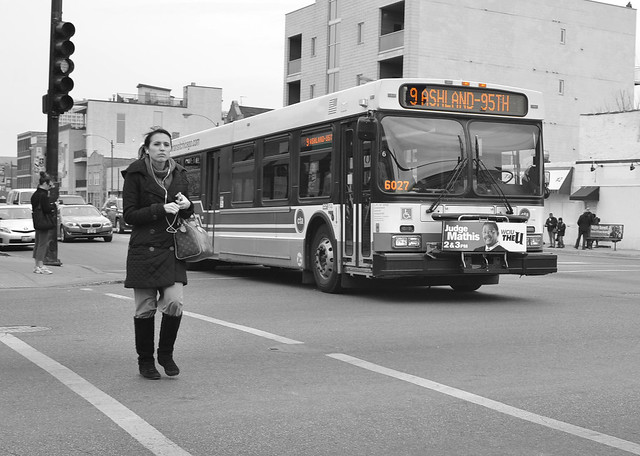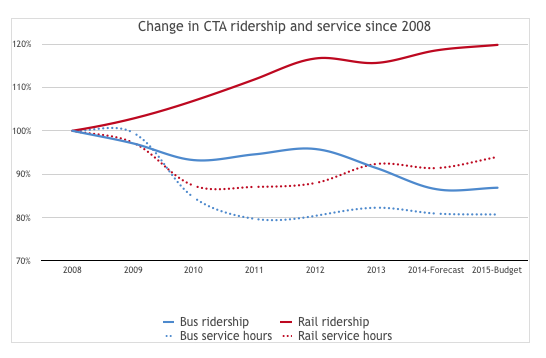
2016 just might be the year of the Chicago bus. The Chicago Transit Authority is restoring express service and speeding up local service on Ashland and Western avenues, running six bus routes on dedicated bus lanes downtown with the new "Loop Link" corridor, and piloting restored service on the #11-Lincoln and #31-31st Street bus routes. Pace will also be gearing up to launch the Pulse "Arterial Bus Rapid Transit" service on Milwaukee Avenue in 2017.
The CTA discontinued express routes on Ashland, Western, and other streets in 2010. The 31st Street route was cut in the late 1990s, and the Lincoln route was truncated in 2012. Red-painted bus-lanes were installed on Loop streets in the 2000s, but the lanes weren't enforced, and they were allowed to fade.
What accounts for the new focus on bus service? For starters, the Chicago Department of Transportation is currently implementing projects that Gabe Klein initiated when he was commissioner between 2011 and 2013. CDOT completed the east-west portion of Loop Link this month, and has begun constructing the Union Station transit center for people to transfer between buses and trains.
In addition to Loop Link, the restored Ashland and Western bus service, which includes the addition of transit-priority stoplights, can be viewed as laying the groundwork for a possible bus rapid transit line on Ashland. The city did outreach and planning for the system in the early years of the Emanuel administration, but it's currently on the back burner.
The restoration of the #11 and #31 lines can be credited to tireless advocacy by local aldermen and a dedicated group of transit riders and businesses called the Crosstown Bus Coalition Last but not least, Dorval Carter took over as CTA president this year, and he said he wanted to pay more attention to improving bus service.
Service changes come with caveats
However, these bus service changes, past and present, have involved tradeoffs. When the CTA cut the #11 route in 2012, it was done as part of the agency's so-called "decrowding plan," which added service to 'L' lines, including the Brown Line, which roughly parallels Lincoln. The current Ashland and Western improvements are possible in part because the CTA is eliminating 100 management positions, including some some layoffs.
Bus ridership is not where it used to be. Last year, CTA attributed drops over the decade to the elimination of Chicago Card discounts, fare increases, and joblessness. Ventra card readers that are only semi-functional may have contributed to either fewer riders, or the reporting of fewer riders.

What’s ultimately clear is that the CTA is providing less bus service: buses come less frequently, for fewer hours a day, or both. It’s easy to think that the CTA is reducing its bus service because fewer people are riding the bus, but it’s also the case that fewer people ride the bus because the CTA provides less service – service frequency is freedom.
CTA itself in better financial situation
Relative to funding for operations, there doesn’t seem to be an end to funding for capital projects, especially from the federal government. They're helping pay for new and rehabilitated buses (a program which the CTA has improved upon drastically since the legislative funding crisis in 2008); transit infrastructure like Loop Link; and the transit-priority signals that will speed up buses on Ashland and Western.
Bloated or inefficient operations isn't CTA's problem anymore. They have squeezed so much efficiency out of their total operation that the only thing left to do is cut either management staff – a bad idea because it gives them less capacity to plan service, and do customer service – or routes or service. A new approach is needed to ensure that people have access to reliable bus and train service that responds to residents' preferred travel times and links up with suburban destinations.
It’s up to legislators to revise laws that distribute tax revenues so that transit – a transportation mode that’s more affordable and sustainable than building highways and buying the cars and fuel required to use them – gets more funding.
Operating funds versus capital projects
Finding funds for capital over operations isn’t a problem specific to Chicago, even though the region compares poorly among peers in how much money it dedicates to run buses and trains. The federal government, in doling out competitive grants through the TIGER program, sometimes gives money to cities and transit agencies for new transit lines that don't guarantee minimum service levels that would secure a healthy ridership for said lines.
There’s work being done to generate more revenue for transit, but advocacy by riders, as we saw with the Crosstown Bus Coalition, it still important because the cities and agencies tend to focus on maintaining existing infrastructure and building more, not finding funding for more service.
The Metropolitan Planning Council leads the Accelerate Illinois campaign, which promotes raising the state gas tax to create a dedicated funding stream for maintaining existing rails, bridges, and roads, and building new infrastructure. The Transit Future campaign, led by the Active Transportation Alliance and the Center for Neighborhood Technology, calls for building new bus and rail rapid transit lines throughout Cook County with a new revenue stream that the county board would enact. The Chicagoland Metropolitan Agency for Planning’s FUND 2040 initiative has the same goal of building and maintaining infrastructure using an increase in sales tax.
Capitol Hill ended transit operations assistance decades ago, and while there's still room to change, it may be more effective to advocate for better transit operations funding at the city, county, and state level. Yet, currently, all three local campaigns focus on capital projects.
![]()
Did you appreciate this post? Streetsblog Chicago is currently funded until April 2016. Consider making a donation through our PublicGood site to help ensure we can continue to publish next year.





